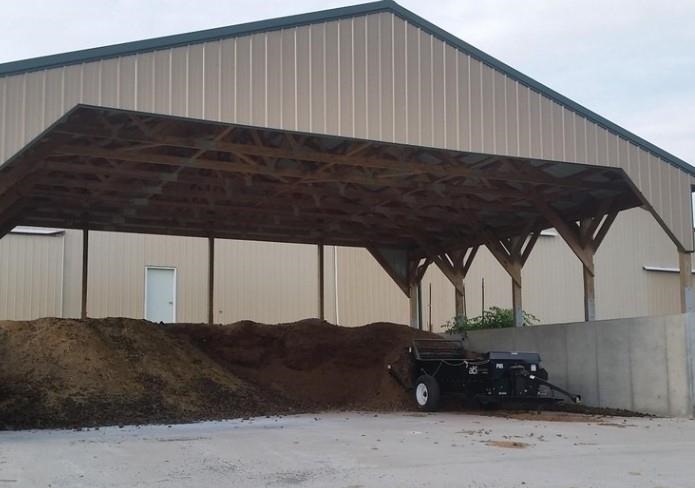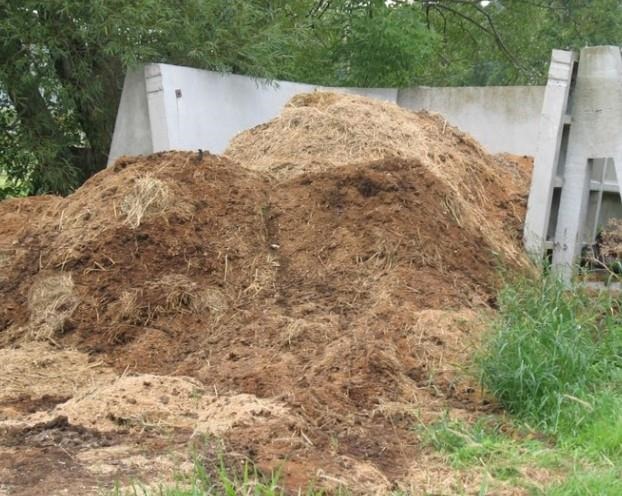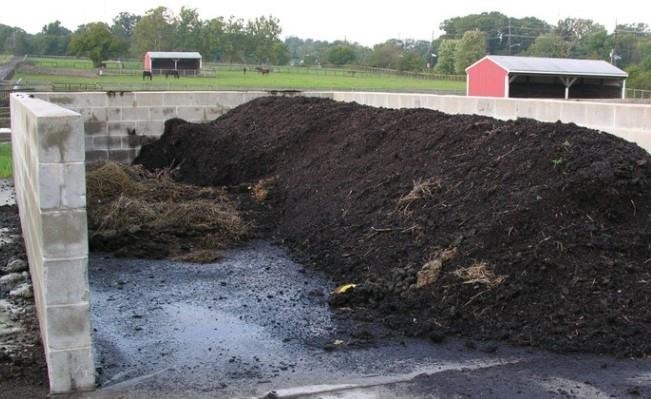By Laura Kenny
A horse owner buys a new property and can't wait to bring their horses home. They make careful decisions about the barn design, the paddock fencing, the watering systems, etc. Finally, everything comes together and the horses arrive! After a month or two, there is a big problem- what to do with all the manure?
Manure storage is often overlooked when designing a farm. Often, the storage gets placed wherever there is space, which is not always the most appropriate spot. Other times it is piled in the woods, in hopes that it will break down to "dirt," which is not acceptable. It is important to choose a suitable location for your manure storage and size it correctly for your situation. This article will outline Pennsylvania manure regulations, show you how to estimate waste production on your farm, provide tips on manure storage locations, and introduce composting.
Pennsylvania Regulations
Most states, including Pennsylvania, have manure storage rules and regulations. In Pennsylvania, any farm that produces or accepts manure within the state must abide by these rules. The rules are in place to protect water quality, since manure contains nutrients (like nitrogen and phosphorus) that can contaminate surface and groundwater and cause environmental harm. There are also regulations for spreading manure and managing Animal Concentration Areas like dry lots. Below we will summarize the requirements for manure storage.
A horse manure pile is usually solid material that can be stacked, which is referred to as a "stockpile" or "stack." Manure that is stacked on the farmstead (i.e., near the barn) must be either on an improved surface (meaning impermeable to water, such as concrete or compacted stonedust) or covered with a roof or tarp. These rules reduce the risk of rainwater picking up nutrients in the manure pile and leaching into the ground or over the ground into a waterway.
Manure that is stacked in areas other than on the farmstead must follow these guidelines:
- Be at least 100 feet away from "sensitive areas" like streams, lakes, ponds, wetlands, drinking water wells, and sinkholes.
- Cannot be placed in an area of concentrated water flow like a swale, ditch, or waterway.
- Be placed on the top of a hill if possible, with upslope stormwater diverted away from the pile (using structures like berms, ditches, French drains, etc.).
- Be placed on areas with less than 8% slope.
- On an improved surface if possible.
- For temporary piles that will be removed and are not on an improved surface, do not place them in the same location each year. If the pile will be in place for more than 120 days, the pile should be covered with a tarp.
Each of these requirements are in place to avoid nutrients leaving the manure pile via stormwater runoff and traveling either to groundwater or surface water.

This manure storage has both a roof and an improved base. Photo credit: Laura Kenny
Additionally, any Pennsylvania farm that produces or accepts manure must have a written manure management plan. There is a specific format to be followed, and some farms with high animal density may need to hire a plan writer. For more information on which plan your farm needs, and how to access the plan template, visit Penn State Extension's Pennsylvania Nutrient Management Program website.
Make sure to check with your township as well, as they may have additional rules to follow.
Sizing the Manure Storage
Farm managers should determine the size of the area they will need for manure storage before building to make sure storage areas will meet their needs. The size of the manure storage will depend on several factors:
- The number and weights of horses on the farm (used to determine the total manure production)
- How much manure is collected and stored vs how much is left in the pasture
- The amount of bedding discarded
- How long between manure removals
This section will walk you through how to calculate an estimate of the waste produced on an example horse farm that has one 1,000-lb horse which is stalled for 16 hours and turned out for 8 hours per day. We will look at both the weight and volume of waste produced; weight can be helpful if you will be applying manure to a field and need to know how much you are applying, and volume is helpful for sizing the manure storage.

This manure storage has been filled beyond its capacity. Photo credit: Laura Kenny.
Manure Production
An average-sized, 1,000-pound horse produces approximately 51 pounds or 0.8 cubic feet of manure (urine + feces) per day. This results in about 9 tons or 290 cubic feet of manure to deal with yearly. Larger horses will produce more, and smaller horses and ponies will produce less. You can estimate how much more or less by multiplying the known amounts of manure production by a factor of your horse’s weight when compared to the standard 1,000-pound horse. For example:
If your horse weighs 1,300 pounds:
- 1,300 lbs/1,000 lbs = 1.3
- Weight: 51 pounds of manure daily x 1.3 = 66 pounds daily
- Volume: 0.8 cubic feet daily x 1.3 = 1.04 cubic feet daily
If your pony weighs 700 pounds:
- 700 lbs/1,000 lbs = 0.7
- Weight: 51 pounds daily x 0.7 = 35.7 pounds daily
- Volume: 0.8 cubic feet daily x 0.7 = 0.56 pounds daily
You could do this for each of your horses individually, or you could estimate an average horse weight for the entire farm or a specific group of horses that are managed similarly. If you decide to just do an average, remember to multiply the manure production by the total number of horses on the farm or in the group.
Turnout Time
Once you know the weight/volume of manure produced on your farm, you will need to consider how much of that manure will end up in your manure pile. If your horses are outside 24/7, and you don't pick up their manure, then you will have very little manure to store. On the other hand, if they are only outside for 8 hours every day, then you will have much more going into your manure pile from stall waste. You can fine tune your total manure estimate based on turnout time by multiplying by a percentage of a 24-hour period. For example (using the 1,000-pound horse):
For a horse turned out 8 hours and stalled 16 hours daily:
- 16 hours/24 hours = 67% of each day spent in stall
- Weight: 51 pounds manure daily * 0.67 (67% manure collected) = 34.2 pounds manure collected daily
- Volume: 0.8 cubic feet daily * 0.67 (67% manure collected) = 0.54 cubic feet collected daily
If your horses' turnout time varies by season, you can calculate each season separately and then add them together, or you could just use an average for the year.
Stall waste
If your horses spend any time in stalls, you will also need to consider the soiled bedding that gets added to the manure pile. This is more difficult to estimate, as bedding preferences vary widely. Different publications estimate soiled stall waste (from 1 horse) to add between 0.6 and 1.6 cubic feet per day and 8-15 pounds per day to the manure pile. It has been suggested that the volume of soiled bedding removed is approximately twice the volume of manure removed (which we just calculated). If you know you bed lightly, you could use an estimate on the lower end of the scale, and if you bed deeply, you could use an estimate on the higher end. The amount of time the horse is stalled will also impact how much soiled bedding you remove in addition to its urine and feces.
For example (using the 1,000-pound horse stalled for 16 hours per day):
- Moderate bedding use (using values in the middle of the ranges presented above): 1 cubic foot of soiled bedding daily, 10 pounds of soiled bedding daily
- Weight: 34.2 pounds manure (calculated from example above) + 10 pounds soiled bedding = 44.2 pounds stall waste collected daily
- Volume: 0.54 cubic feet manure + 1 cubic foot soiled bedding = 1.54 cubic feet stall waste collected daily
Other Additions
Do you routinely pick manure from your dry lots? That could add some volume to the pile. If you feed hay outside, do you pick up the wasted hay and toss it on the pile? Think about any other things that you throw on the manure pile and give a rough estimate for weight/volume per day.
Time Between Manure Removals
Lastly, you should determine how often you would like to have the manure storage emptied. A manure storage that needs to last 6 months will be much larger than one that needs to last 1 month. Since manure piles may be difficult to access and remove in the winter, it is recommended to size them for 5-6 months of waste accumulation.
Once you know how long the stack will be present, you can take your manure and bedding estimate and multiply it by the number of days. Building on the last example:
If you will need a 6-month (182 days) storage period:
- Weight: 44.2 pounds stall waste * 182 days = 8,044 pounds (4 tons) in 6 months
- Volume: 1.54 cubic feet stall waste * 182 days = 280 cubic feet in 6 months
Remember that these calculations were for one horse under specific conditions (i.e., horse weight, turnout time, bedding use). While the numbers are only an estimate, they can give you an idea of how much manure you will need to plan for. If you are not comfortable running the calculations, you could contact an agricultural engineer, your local USDA-Natural Resources Conservation Service office, or your local County Conservation District for assistance.
Final Volume and Shape
Now we have an estimate for volume, which is required for determining the size of your manure storage. However, estimates are just that - not perfect. A few other factors will affect the final size of the manure storage:
- Settling. The pile will settle over time, shrinking its volume a bit. If it sits for several months, it may begin to break down and shrink even more.
- Pile Height. If you are limited to using a wheelbarrow or muck tub on ground level to add to the pile, it will not be very tall and will need a larger footprint. If you have equipment like a skid steer to push the manure pile higher, then you can use a smaller footprint. Using a bank to drop manure into the storage also helps.
- Pile Shape. Manure doesn't easily form a perfect cube shape; rather, it tends to mound with a curved top and sloping sides. This makes sizing based on volume more difficult. Depending on your manure storage design, you will need a little extra space for sloping sides. A stand-alone pile (roughly cone-shaped) will need significantly more space than a pile with 3 walls.
There are many important considerations and tips for building a good manure storage, especially when it has a solid base and walls. Some of them can be found in Horse Stable Manure Management . For technical assistance with sizing and designing a manure storage, contact an agricultural engineer, your local USDA-Natural Resources Conservation Service office, or your local County Conservation District.

A creative approach to filling a manure dumpster when only wheelbarrows are available. Photo credit: Danielle Smarsh
Tips for the Manure Storage Location
The Pennsylvania manure management regulations listed in the beginning of this article provide some rules for siting the manure storage. However, here are some other suggestions for your property that are not state law, but may be helpful:
- Locate the storage away from property lines to reduce odors reaching neighbors. "Out of sight, out of mind" is a good phrase to live by.
- You want the storage to be close enough to the barn to be convenient, but far enough to reduce flies and odors around the horses.
- If you plan to have someone remove the manure for you, how easily can they access the pile? Can a big dump truck get there? What if it’s muddy? Do you need a stabilized driveway or extended apron in front of the storage to avoid tires tearing up the ground?
- Do not locate your manure storage in a turnout area.
- Grass is an excellent filter for contaminated liquid runoff leaving the pile; try to surround the storage with grass as much as possible. If there is any slope to the area, this grass buffer should be downslope of the storage and 2-3 times the depth of the storage.
- It is not appropriate to dump manure in the woods. Dumping manure adds nutrients like nitrogen, phosphorus, and potassium to the area. When we add these nutrients to crops as fertilizer, they are also removed from the field with the harvested material. Since we do not harvest a crop from the woods where manure is dumped, these nutrients build up to very high levels in the soil, causing a potential for surface and groundwater contamination and pollution.
Composting Manure
Many horse farm owners are interested in composting their manure. It produces a safe, valuable product and reduces the volume of your manure pile. However, there are some misconceptions about what is composting and what isn't.
Composting is a managed process, requiring oxygen and air flow, that utilizes microbes present in the manure pile and the heat they produce to break down the manure into a stable, odorless product. Composting is not just letting a pile sit for a year and decompose. Yes, the material will still break down, but it is decomposing in an anaerobic, often smelly process.
Turning the pile is an important part of composting. The pile heats to temperatures up to 160°F, which kills parasite and fly eggs, weed seeds, and some pathogens. However, if the pile is never turned, the outer layer of the pile never reaches these temperatures and does not compost.
True composting requires several factors to work:
- Oxygen. A well-structured pile has space for air and water to flow. Composting microbes require oxygen to do their job.
- Moisture. Optimal moisture levels are 40-65%, or similar to the feel of a wrung-out sponge.
- Raw materials in proper carbon:nitrogen ratio. Horse manure by itself has a good C:N ratio for composting (about 30:1), but bedding is very high in carbon and can raise the C:N ratio considerably.
- Temperature. The temperature will rise as a result of microbial activity, but the pile should be turned before it reaches 160F to avoid killing the beneficial microbes.
- Time. The time required to fully compost a manure pile will vary based on the factors listed above and the method used to compost. Compost is done when it returns to ambient temperatures.
A low-effort composting method is called passive composting. If the compost pile is small enough (no larger than 12' at the base and 6' in height), then the heat of composting will pull cool air in at the base of the pile and release warm air at the top of the pile, thus aerating itself. The pile needs structure that allows air flow, so a dense, wet pile may not compost as well. It still needs to be turned to mix the ingredients thoroughly so that the entire pile gets exposed to the interior heat. The minimum size for a pile to begin heating is 3'x3'x3'. This method may take up to a year to fully compost your manure pile.

Properly composted manure looks more like soil than manure, but it is not soil; it still contains manure nutrients. Photo credit: Laura Kenny
More intensive composting methods can include passive aeration using perforated pipes or active aeration using air pumps. These can be more complicated and expensive to set up, but they speed up the composting process.
For more details on composting horse manure, watch this webinar or see the references.
Conclusions
Dealing with horse manure may not be the most rewarding aspect of horse ownership, but it is important to do it right. Follow the Pennsylvania (or your state) and township manure management regulations and complete any required written plans. Use best management practices to keep manure and contaminated runoff away from surface water. Composting is feasible on many horse farms and produces a valuable end product if done correctly.
Source : psu.edu